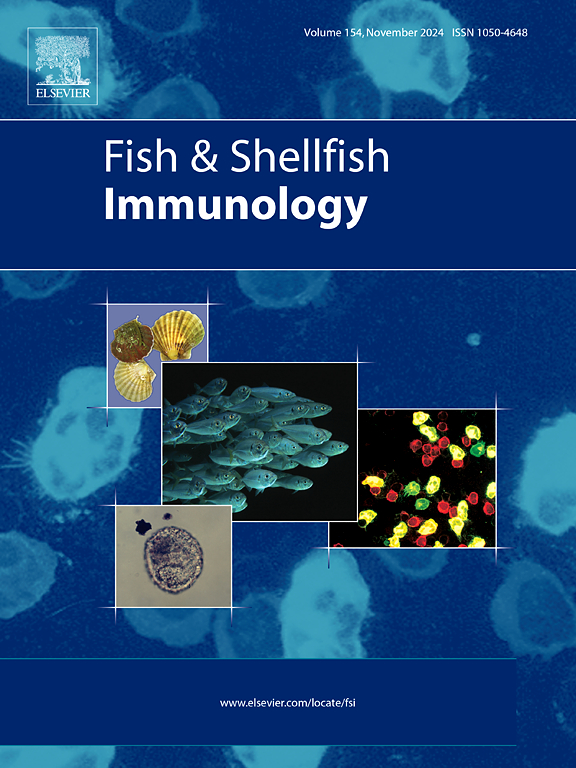Screening of immunogenic antigens from scuticociliate in Takifugu rubripes, and the development and evaluation of subunit vaccines
IF 4.1
2区 农林科学
Q1 FISHERIES
引用次数: 0
Abstract
In recent years, scuticociliatosis has emerged as a major parasitic disease in the aquaculture of Takifugu rubripes, inflicting significant economic losses on the pufferfish farming industry. The conventional approach of using chemical drugs to prevent and control parasitic diseases poses substantial risks to the environment and food safety. Consequently, the utilization of vaccines for the prevention and treatment of aquatic animal diseases is currently regarded as the mainstream direction for future aquatic animal disease prevention and control. In this study, utilizing the laboratory-established pathogenic strain of scuticociliates, Pseudocohnilembus persalinus, as the immunogen, we aimed to screen for immunogenic proteins capable of eliciting immune responses in hosts. Through enrichment culture of P. persalinus in vitro, impurities were filtered out using membranes, and the organisms were subsequently collected by centrifugation, frozen-thawed and disrupted to obtain whole-cell proteins. BALB/c mice and T. rubripes served as the immunization subjects, receiving intraperitoneal injections of the proteins to generate polyclonal antisera against scuticociliates. Western blot analysis was then performed, incubating the whole-cell proteins with mouse and T. rubripes antisera. The most intensely stained protein bands were excised, subjected to gel excision and mass spectrometry for identification and comparison. The resulting identified gene, SDP35, belongs to the GAPDH (glyceraldehyde-3-phosphate dehydrogenase) family and exhibits the following characteristics: The SDP35-encoded polypeptide chain comprises two protein domains: the N-terminal coenzyme NAD-binding domain and the C-terminal catalytic domain, which are distinctive features of this family of proteins. The SDP35 protein is primarily localized in the cytoplasm, consistent with GAPDH's function in catalyzing glycolysis within the cytoplasm. In addition, the SDP35 gene bears some ciliate-specific traits, notably the presence within its open reading frame of ten non-canonical glutamine-encoding codons (TAA), which serve as stop codons in most other organisms. Toxicity challenge experiments were conducted on T. rubripes before and after vaccination, revealing that the subunit vaccine against scuticociliates significantly reduced the scuticociliate density at the wound site of T. rubripes. The parasite reduction rate reached 80.39 %. Concurrently, the vaccine enhanced the activity of acetylcholinesterase (ACH), peroxidase (POD), and total superoxide dismutase (T-SOD) in T. rubripes, thereby strengthening its anti-infective capability and exerting a preventive effect against scuticociliatosis.
红鳍东方鲀囊尾蚴免疫原性抗原的筛选及亚单位疫苗的研制与评价
近年来,棘条病已成为红鳉鱼养殖中的一种主要寄生虫病,给河豚养殖业造成了重大的经济损失。使用化学药物预防和控制寄生虫病的传统方法对环境和食品安全构成重大风险。因此,利用疫苗预防和治疗水生动物疾病被认为是未来水生动物疾病防控的主流方向。在这项研究中,我们利用实验室建立的scuticociiliates致病菌株Pseudocohnilembus persalinus作为免疫原,旨在筛选能够在宿主中引发免疫反应的免疫原性蛋白。通过对P. persalinus的体外富集培养,用膜过滤掉杂质,然后通过离心、冻融和破坏收集生物体,获得全细胞蛋白。以BALB/c小鼠和红毛t猴为免疫对象,腹腔注射该蛋白生成抗裸肩虫多克隆血清。然后进行Western blot分析,将全细胞蛋白与小鼠和红带绦虫抗血清孵育。将染色最强烈的蛋白条带切除,用凝胶切除和质谱法进行鉴定和比较。所鉴定的基因SDP35属于GAPDH(甘油醛-3-磷酸脱氢酶)家族,并具有以下特征:SDP35编码的多肽链包含两个蛋白结构域:n端辅酶nadd结合结构域和c端催化结构域,这是该蛋白家族的显著特征。SDP35蛋白主要定位于细胞质中,与GAPDH在细胞质内催化糖酵解的功能一致。此外,SDP35基因具有一些纤毛虫特有的特征,特别是在其开放阅读框中存在10个非规范谷氨酰胺编码密码子(TAA),这些密码子在大多数其他生物中起停止密码子的作用。对接种前后的红带绦虫进行了毒性挑战实验,结果表明,抗肩胛骨亚单位疫苗显著降低了红带绦虫创面部位的肩胛骨密度。寄生虫减少率达80.39%。同时,该疫苗增强了红带绦虫体内乙酰胆碱酯酶(ACH)、过氧化物酶(POD)和总超氧化物歧化酶(T-SOD)的活性,从而增强了其抗感染能力,对丝虫病起到了预防作用。
本文章由计算机程序翻译,如有差异,请以英文原文为准。
求助全文
约1分钟内获得全文
求助全文
来源期刊

Fish & shellfish immunology
农林科学-海洋与淡水生物学
CiteScore
7.50
自引率
19.10%
发文量
750
审稿时长
68 days
期刊介绍:
Fish and Shellfish Immunology rapidly publishes high-quality, peer-refereed contributions in the expanding fields of fish and shellfish immunology. It presents studies on the basic mechanisms of both the specific and non-specific defense systems, the cells, tissues, and humoral factors involved, their dependence on environmental and intrinsic factors, response to pathogens, response to vaccination, and applied studies on the development of specific vaccines for use in the aquaculture industry.
 求助内容:
求助内容: 应助结果提醒方式:
应助结果提醒方式:


